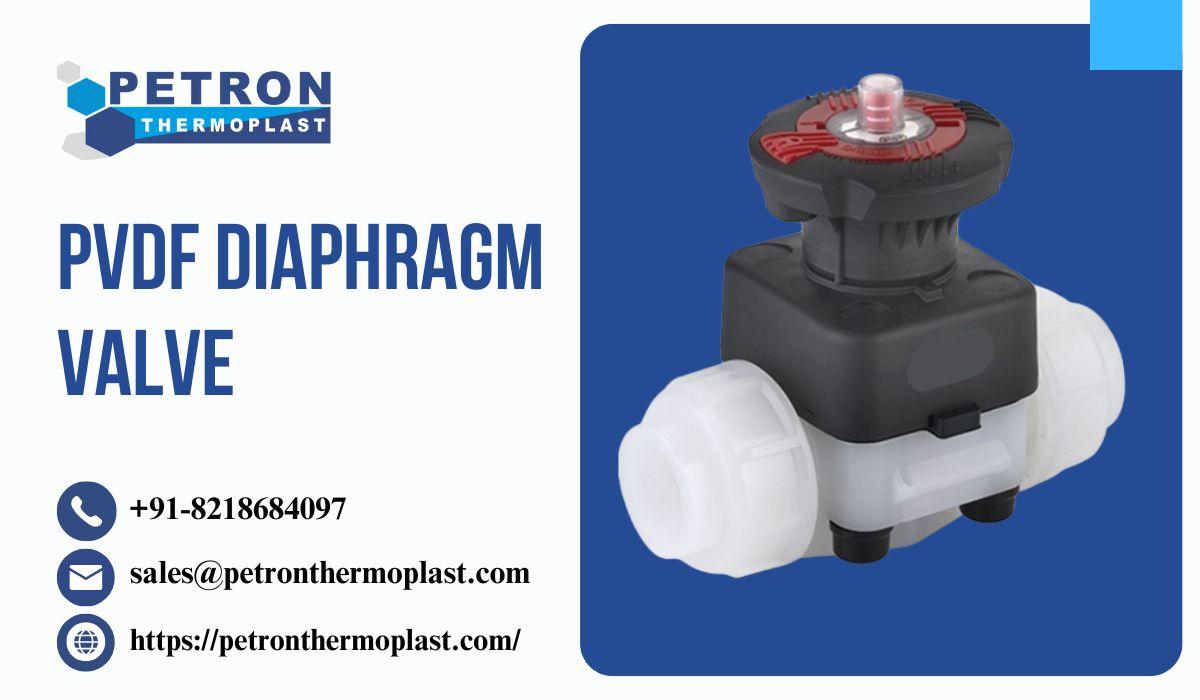In demanding industrial environments, where corrosive fluids and high-purity requirements are standard, selecting the right valve is critical to the reliability, safety, and efficiency of a piping system. Among the various valve types and materials available, the PVDF diaphragm valve stands out as a superior choice. Known for its exceptional chemical resistance, durability, and precise flow control, PVDF diaphragm valves have become indispensable in sectors like chemical processing, pharmaceuticals, semiconductors, and water treatment.
In this article, we’ll explore what PVDF diaphragm valves are, their unique features, advantages, and how they support high-performance fluid control under harsh and sensitive conditions.
What is a PVDF Diaphragm Valve?
A PVDF (Polyvinylidene Fluoride) diaphragm valve is a type of flow control valve designed with a flexible diaphragm that regulates or blocks the flow of fluids. The diaphragm is typically made of a chemical-resistant elastomer or PTFE, while the body is molded from PVDF, a high-performance thermoplastic with excellent chemical and thermal resistance.
This valve operates by pressing the diaphragm against a weir or seat in the valve body, creating a seal. When the diaphragm lifts, fluid flows through; when it presses down, flow stops. This design makes PVDF diaphragm valves ideal for controlling aggressive chemicals and ultra-pure fluids with minimal risk of contamination or leakage.
Key Features of PVDF Diaphragm Valves
🧪 Exceptional Chemical Resistance
PVDF is highly resistant to most acids, bases, and solvents, including concentrated hydrochloric acid, nitric acid, chlorine, and ozone. This makes the valve suitable for use in environments that would rapidly corrode metal or other plastic materials.
🌡️ High Temperature Tolerance
PVDF can operate effectively at temperatures up to 120°C (248°F), allowing its use in hot fluid applications where other plastics like PVC or CPVC may fail.
💧 Precise Flow Control
The diaphragm design enables precise modulation of flow, making it suitable for dosing systems and applications where flow accuracy is essential.
🔧 Zero Contamination Design
The smooth, crevice-free internal surface and minimal moving parts reduce the risk of contamination, making these valves ideal for clean-in-place (CIP) and sterile processes.
🧼 Easy to Maintain
With only a few moving components and accessible internals, PVDF diaphragm valves are easy to clean, inspect, and maintain, reducing downtime in critical processes.
🔒 Leak-Free Seal
The flexible diaphragm creates a bubble-tight seal across the flow path, preventing leaks even under high-pressure or vacuum conditions.
Advantages of Using PVDF Diaphragm Valves
✅ Corrosion-Free Operation
Thanks to PVDF’s natural resistance to chemical attack, these valves don’t corrode, rust, or degrade when exposed to harsh chemicals, unlike metal alternatives.
✅ Long Service Life
Their rugged design and chemical durability ensure long-term operation with minimal need for replacement, even in aggressive chemical environments.
✅ Low Permeability
PVDF offers extremely low permeability, making it ideal for transporting high-purity fluids or gases without contamination from external sources.
✅ Smooth Internal Surfaces
Reduced surface roughness in PVDF valves minimizes friction and prevents the buildup of residues, making them suitable for ultra-pure or pharmaceutical-grade fluids.
✅ Available in Manual and Automated Options
PVDF diaphragm valves can be manually operated or automated using pneumatic or electric actuators for process automation and remote control.
Applications of PVDF Diaphragm Valves
PVDF diaphragm valves are used in a wide range of industrial and high-purity applications. Their durability and chemical inertness make them ideal for:
🔹 Chemical Processing Plants
Used in systems handling strong acids, alkalis, or solvents where traditional materials degrade quickly.
🔹 Pharmaceutical Manufacturing
Perfect for sterile or cleanroom environments, PVDF valves help maintain hygienic conditions and avoid product contamination.
🔹 Semiconductor Industry
In ultra-pure water (UPW) systems and etching processes, PVDF valves offer non-leaching, contaminant-free fluid control.
🔹 Water Treatment Facilities
Used in both municipal and industrial plants for handling chlorine, ozone, and other aggressive water treatment chemicals.
🔹 Food and Beverage Processing
With FDA compliance, PVDF valves are safe for use in food and beverage manufacturing, particularly in CIP and SIP applications.
🔹 Laboratory and Analytical Equipment
In lab setups requiring precise dosing of acids or corrosive reagents, PVDF diaphragm valves deliver controlled performance.
Installation and Maintenance Tips
- Proper Alignment – Always align the valve correctly to prevent stress on the body or connections.
- Material Compatibility – Ensure the diaphragm and valve body are compatible with the chemical media.
- Avoid Over-Tightening – Use torque specifications for flanged or threaded connections to avoid cracking.
- Regular Inspection – Periodically inspect the diaphragm for wear, especially in systems with aggressive media.
- Flush Before Use – Clean the valve and connected piping before introducing critical fluids to avoid contamination.
Why Choose a PVDF Diaphragm Valve Over Other Valve Types?
While metal and other plastic valves are commonly used in industrial systems, PVDF diaphragm valves offer specific advantages where chemical resistance and purity are critical:
| Comparison Factor | PVDF Diaphragm Valve | Metal Valve | PVC/CPVC Valve |
| Chemical Resistance | Excellent | Moderate to Poor | Good to Moderate |
| High-Temperature Tolerance | Up to 120°C | Varies | Lower (60–90°C) |
| Cleanroom Suitability | Excellent | Moderate | Poor to Moderate |
| Leak Protection | Excellent | Moderate | Moderate |
| Maintenance Requirements | Low | Moderate to High | Low |
Conclusion
For industries that demand precision, reliability, and resistance to aggressive chemicals, the PVDF diaphragm valve is a top-tier solution. Its unique combination of chemical inertness, clean flow control, and durable construction makes it a smart investment for critical fluid systems.Whether you’re designing a high-purity pharmaceutical line, a chemical dosing skid, or a semiconductor wet bench, PVDF diaphragm valves ensure leak-free operation, long life, and contamination-free flow—making them one of the most trusted valve types in advanced industrial systems.



